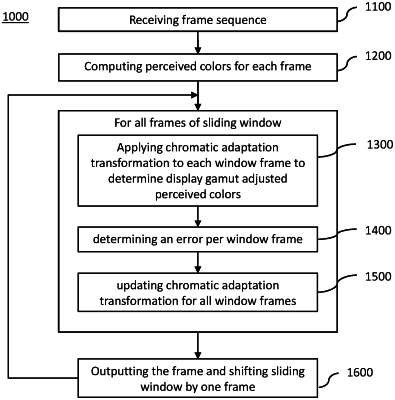| CPC G09G 5/06 (2013.01) [G09G 5/04 (2013.01); G09G 2320/0693 (2013.01); G09G 2340/06 (2013.01)] | 19 Claims |

|
1. A computer-implemented method for increasing a perceived gamut (PG) of a physical display device presenting frames of an image sequence to a human viewer wherein the display gamut (DG) of the display device is given by the primary colors of the display device, the method comprising:
receiving a sequence of frames with each frame having input color data associated with each pixel of the respective frame, the input color data being given in a specified color space;
for each particular frame of the received sequence:
computing, in the LMS color space, perceived colors of each pixel of the particular frame based on the input color data of the particular frame and a frame-specific adapted white point, wherein the frame-specific adapted white point is the white point to which the viewer would be adapted when watching the particular frame on a display capable of showing all perceivable colors;
for all window frames of a sliding window starting with a current frame and ending with a future frame:
applying, in the LMS color space, a chromatic adaptation transformation to each window frame to determine display gamut adjusted perceived colors of each pixel of the respective frame based on a mapping of the corresponding input color data to the display gamut, and based on a corresponding display gamut adjusted adapted white point;
determining an error per window frame wherein the error reflects the difference between the computed perceived colors and the determined display gamut adjusted perceived colors of the respective window frame;
updating the chromatic adaptation transformation for all window frames to minimize a total determined error; and
outputting, in the color space of the physical display, a predefined number of frames of the sliding window following the current frame, and shifting the sliding window by the predefined number of frames.
|